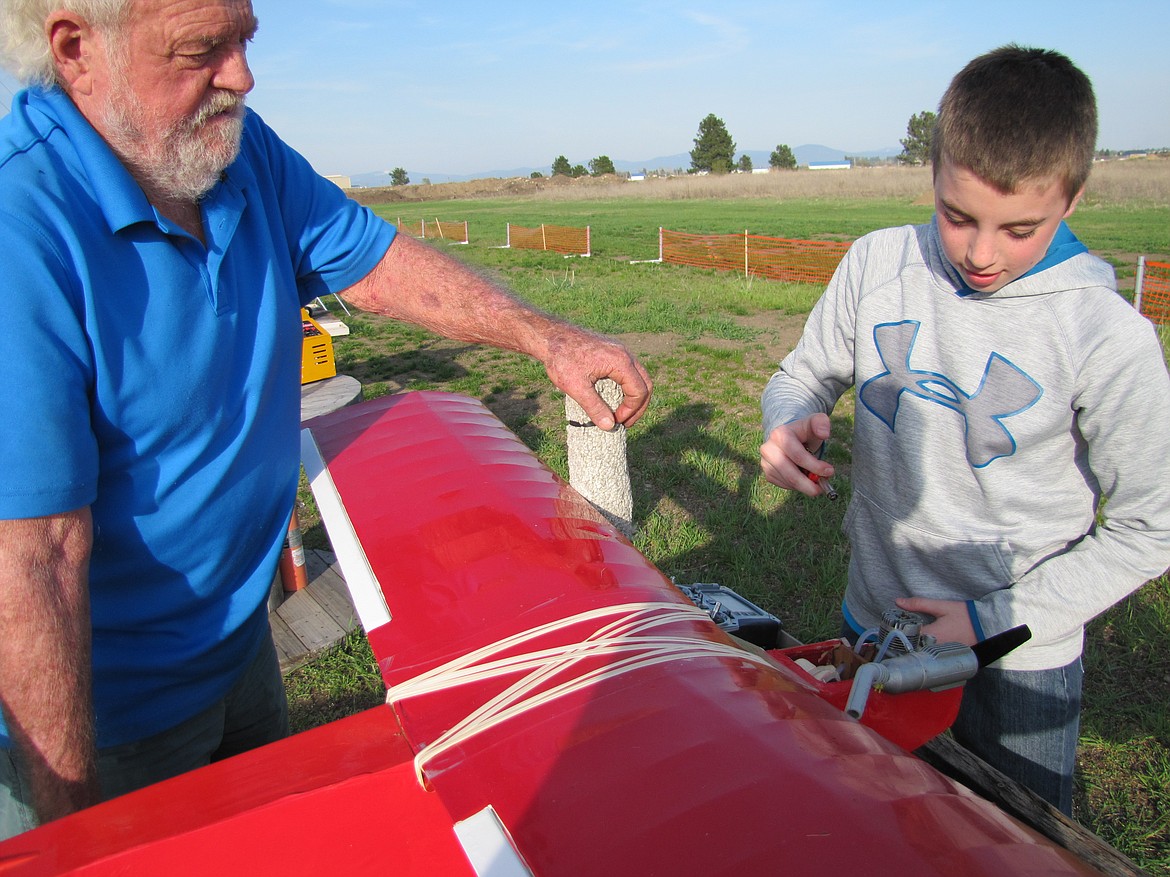Model flyers
Keith Erickson Coeur Voice Writer | Hagadone News Network | UPDATED 7 years, 7 months AGO
Thirteen-year-old Jamison Brunner looked anxiously at the four-stroke model airplane perched on the prep table alongside a makeshift “airstrip” located discreetly on the Rathdrum Prairie.
“I’m not going to fly it,” Jamison firmly told his grandpa and flying partner, Don Blaine.
Although the seventh grader had just flown a smaller plane with smooth landings and takeoffs, he was leery of the larger aircraft—a Magnum 70—with a daunting 6-foot wingspan.
But after some reassurance from his grandpa, Jamison seized the control box. Minutes later, the boy was in airplane heaven.
“Wow, this handles way better,” he said, eyes fixed intently on the plane soaring overhead as he confidently maneuvered a near-perfect flight.
“It’s all hand-eye coordination,” Blaine said.
And he should know—the 77-year-old Twin Lakes resident has been building and flying model planes virtually all his life.
He introduced Jamison to the sport on a Christmas day when the youngster was barely 2 years old. The inquisitive boy has been flying ever since.
“That’s my sport; it’s what I do. I love flying these planes,” Jamison says.
The teenager and his grandpa are not alone in their passion for remote-controlled model aviation.
Frequent flyers
The Coeur d’Alene AeroModeling Society (CAMS) is a high-flying group that meets on a well-maintained airstrip on the Rathdrum Prairie just off Highway 41. The 7-acre tract includes 5-and-a-half acres of mowed grass used for takeoffs and landings, and a 550-foot by 40-foot paved runway, says CAMS president Dennis Edelbrock.
CAMS was formed nearly 30 years ago and meets regularly to test members’ aeronautic skills with their RC (remote controlled) planes.
“It started with a bunch of people who just wanted to build and fly their model airplanes via control,” Edelbrock says.
While the group, which currently has 78 members, comprises mostly middle-aged and retired men, it accepts anybody who loves to fly or build model airplanes. It has welcomed members, men and women, ranging in age from 14 to 102 years old.
Edelbrock is quick to point out that CAMS is just as much a social club as it is a flyers fraternity.
“Camaraderie for everybody out there is at least half the sport,” Edelbrock says. “You get to the field and kind of settle down and fly for 10 to 15 minutes then you come back and BS with other group members.”
Friendships are forged when long-timers help newbies.
“New guys can learn a lot from older guys about how to build, repair, fly, do maneuvers and how to improve landings and takeoffs,” he says. “You can’t open a book and get a lot of this stuff. The guys who have been around awhile are great repositories for a lot of this information.”
Getting your foot in the door to RC flying can cost as little as a couple hundred dollars for an almost-ready-to-fly electric model, and up to thousands of dollars for fuel-powered planes with wing spans stretching to 12 feet and take many weeks to put together.
Training those who are new to the sport is critical, Edelbrock says, and a solo license is required to affirm that the RC operators know how to take off, land and fly in a safe manner before they can take to the skies on their own.
Looking for a new home
After 27 years at its current location off Highway 41, CAMS is looking for new land. A Highway 41 widening project will displace the group in about two years and Edelbrock says CAMS is actively looking for a new parcel, preferably on the Prairie.
The group needs at least three acres for the runway and parking and the right to fly over at least 30-plus acres. The land arrangement would be similar to the existing contract, in which CAMS serves as caretaker for the property. The group is a good steward to its current location, a commitment that would follow through at its new site, Edelbrock says.
CAMS is registered with the Academy of Model Aeronautics (AMA) and carries a $500,000 insurance policy to protect the group and any land owner within the airspace who might be impacted by the flyers.
Furthermore, Edelbrock noted, the group’s AMA affiliation is in cooperation with the Federal Aviation Administration, which established the rules by which CAMS operates.
Sky’s the limit
While many of his friends may be sitting at home in front of the TV focused on an XBox, Jamison is quite content out on the airstrip alongside his grandfather commanding the flight operations of various RC aircrafts.
While still young in years, Jamison has already accumulated an impressive arsenal of memories on the airfield. And it all began with a special gift.
“I remember on that Christmas day when grandpa came in with a huge box—it was an airplane,” Jamison says. “I’ll never forget that.”
ARTICLES BY KEITH ERICKSON COEUR VOICE WRITER

Job placement rate high for Project SEARCH
What is it? Project SEARCH was first developed in 1996 at Cincinnati Children’s Hospital to provide employment and education opportunities for individuals with significant disabilities.

Cutting edge keepsakes
Ask any new parent about their baby’s early achievements and they’ll likely confirm the cliché: “They grow up so fast.” And because moms and dads can’t turn back the clock, documenting those first few months in “real time” can be critical to creating a detailed lifetime of memories.

Vigor and vibration
Technology used in the 1970s to keep Soviet cosmonauts in outer space for a longer period of time is being used right here on Earth for an array of physical benefits—from alleviating chronic pain and fighting osteoporosis to treating neurological disorders and helping athletes perform better and recover faster.



